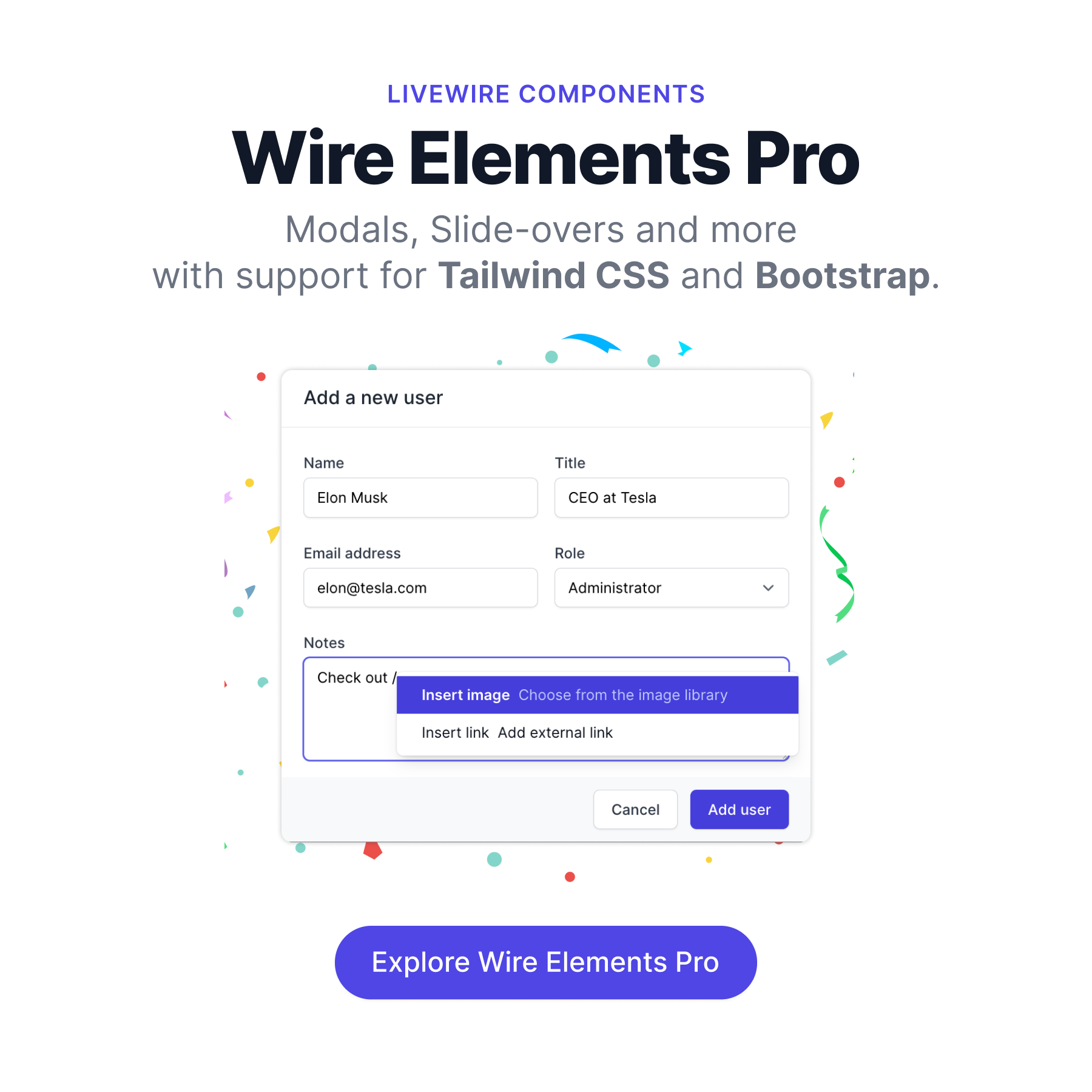wire-elements/modal
Laravel Livewire modal component
Downloads
Stars
Version
Livewire v3
This is the readme for Livewire v3. If you are looking for the readme for Livewire v2 click here.
Upgrading from v2
You can use the following command to automate the upgrade process:
php artisan livewire:upgrade --run-only wire-elements-modal-upgrade
Please review the changes and ensure they follow the new convention set by Livewire v3:
<-- Before -->
<button wire:click="$emit('openModal', 'users')">Show Users</button>
<!-- After -->
<button wire:click="$dispatch('openModal', {component: 'users'})">Show Users</button>
<-- Before -->
<button wire:click="$emit('openModal', 'edit-user', {user: 5})">Edit User</button>
<!-- After -->
<button wire:click="$dispatch('openModal', {component: 'edit-user', arguments: {user: 5}})">Edit User</button>
The old component name is being deprecated. Replace @livewire('livewire-ui-modal') with @livewire('wire-elements-modal').
The config file has been renamed as well. If you've published the config in the past, you will have to do so again and make the necessary changes:
php artisan vendor:publish --tag=wire-elements-modal-config
After upgrading, make sure to clear your view cache:
php artisan view:clear
About Wire Elements Modal
Wire Elements Modal is a Livewire component that provides you with a modal that supports multiple child modals while maintaining state.
Installation
Click the image above to read a full article on using the Wire Elements modal package or follow the instructions below.
To get started, require the package via Composer:
composer require wire-elements/modal:^2.0
Livewire directive
Add the Livewire directive @livewire('wire-elements-modal') directive to your template.
<html>
<body>
<!-- content -->
@livewire('wire-elements-modal')
</body>
</html>
TailwindCSS
The base modal is made with TailwindCSS. If you use a different CSS framework I recommend that you publish the modal template and change the markup to include the required classes for your CSS framework.
php artisan vendor:publish --tag=wire-elements-modal-views
Creating a modal
You can run php artisan make:livewire EditUser to make the initial Livewire component. Open your component class and make sure it extends the ModalComponent class:
<?php
namespace App\Http\Livewire;
use LivewireUI\Modal\ModalComponent;
class EditUser extends ModalComponent
{
public function render()
{
return view('livewire.edit-user');
}
}
Opening a modal
To open a modal you will need to dispatch an event. To open the EditUser modal for example:
<!-- Outside of any Livewire component -->
<button onclick="Livewire.dispatch('openModal', { component: 'edit-user' })">Edit User</button>
<!-- Inside existing Livewire component -->
<button wire:click="$dispatch('openModal', { component: 'edit-user' })">Edit User</button>
<!-- Taking namespace into account for component Admin/Actions/EditUser -->
<button wire:click="$dispatch('openModal', { component: 'admin.actions.edit-user' })">Edit User</button>
Passing parameters
To open the EditUser modal for a specific user we can pass the user id:
<!-- Outside of any Livewire component -->
<button onclick="Livewire.dispatch('openModal', { component: 'edit-user', arguments: { user: {{ $user->id }} }})">Edit User</button>
<!-- Inside existing Livewire component -->
<button wire:click="$dispatch('openModal', { component: 'edit-user', arguments: { user: {{ $user->id }} }})">Edit User</button>
<!-- If you use a different primaryKey (e.g. email), adjust accordingly -->
<button wire:click="$dispatch('openModal', { component: 'edit-user', arguments: { user: {{ $user->email }} }})">Edit User</button>
<!-- Example of passing multiple arguments -->
<button wire:click="$dispatch('openModal', { component: 'edit-user', arguments: { user: {{ $user->id }}, advancedMode: true }})">Edit User</button>
The parameters are injected into the modal component and the model will be automatically fetched from the database if the type is defined:
<?php
namespace App\Http\Livewire;
use App\Models\User;
use LivewireUI\Modal\ModalComponent;
class EditUser extends ModalComponent
{
// This will inject just the ID
// public int $user;
public User $user;
public function mount()
{
Gate::authorize('update', $this->user);
}
public function render()
{
return view('livewire.edit-user');
}
}
The parameters are also passed to the mount method on the modal component.
Opening a child modal
From an existing modal you can use the exact same event and a child modal will be created:
<!-- Edit User Modal -->
<!-- Edit Form -->
<button wire:click="$dispatch('openModal', { component: 'delete-user', arguments: { user: {{ $user->id }} }})">Delete User</button>
Closing a (child) modal
If for example a user clicks the 'Delete' button which will open a confirm dialog, you can cancel the deletion and return to the edit user modal by dispatching the closeModal event. This will open the previous modal. If there is no previous modal the entire modal component is closed and the state will be reset.
<button wire:click="$dispatch('closeModal')">No, do not delete</button>
You can also close a modal from within your modal component class:
<?php
namespace App\Http\Livewire;
use App\Models\User;
use LivewireUI\Modal\ModalComponent;
class EditUser extends ModalComponent
{
public User $user;
public function mount()
{
Gate::authorize('update', $this->user);
}
public function update()
{
Gate::authorize('update', $this->user);
$this->user->update($data);
$this->closeModal();
}
public function render()
{
return view('livewire.edit-user');
}
}
If you don't want to go to the previous modal but close the entire modal component you can use the forceClose method:
public function update()
{
Gate::authorize('update', $this->user);
$this->user->update($data);
$this->forceClose()->closeModal();
}
Often you will want to update other Livewire components when changes have been made. For example, the user overview when a user is updated. You can use the closeModalWithEvents method to achieve this.
public function update()
{
Gate::authorize('update', $this->user);
$this->user->update($data);
$this->closeModalWithEvents([
UserOverview::class => 'userModified',
]);
}
It's also possible to add parameters to your events:
public function update()
{
$this->user->update($data);
$this->closeModalWithEvents([
UserOverview::class => ['userModified', [$this->user->id]],
]);
}
Changing modal properties
You can change the width (default value '2xl') of the modal by overriding the static modalMaxWidth method in your modal component class:
/**
* Supported: 'sm', 'md', 'lg', 'xl', '2xl', '3xl', '4xl', '5xl', '6xl', '7xl'
*/
public static function modalMaxWidth(): string
{
return 'xl';
}
By default, the modal will close when you hit the escape key. If you want to disable this behavior to, for example, prevent accidentally closing the modal you can overwrite the static closeModalOnEscape method and have it return false.
public static function closeModalOnEscape(): bool
{
return false;
}
By default, the modal will close when you click outside the modal. If you want to disable this behavior to, for example, prevent accidentally closing the modal you can overwrite the static closeModalOnClickAway method and have it return false.
public static function closeModalOnClickAway(): bool
{
return false;
}
By default, closing a modal by pressing the escape key will force close all modals. If you want to disable this behavior to, for example, allow pressing escape to show a previous modal, you can overwrite the static closeModalOnEscapeIsForceful method and have it return false.
public static function closeModalOnEscapeIsForceful(): bool
{
return false;
}
When a modal is closed, you can optionally enable a modalClosed event to be fired. This event will be fired on a call to closeModal, when the escape button is pressed, or when you click outside the modal. The name of the closed component will be provided as a parameter;
public static function dispatchCloseEvent(): bool
{
return true;
}
By default, when a child modal is closed, the closed components state is still available if the same modal component is opened again. If you would like to destroy the component when its closed you can override the static destroyOnClose method and have it return true. When a destroyed modal is opened again its state will be reset.
public static function destroyOnClose(): bool
{
return true;
}
Skipping previous modals
In some cases you might want to skip previous modals. For example:
- Team overview modal
- -> Edit Team
- -> Delete Team
In this case, when a team is deleted, you don't want to go back to step 2 but go back to the overview.
You can use the skipPreviousModal method to achieve this. By default it will skip the previous modal. If you want to skip more you can pass the number of modals to skip skipPreviousModals(2).
<?php
namespace App\Http\Livewire;
use App\Models\Team;
use LivewireUI\Modal\ModalComponent;
class DeleteTeam extends ModalComponent
{
public Team $team;
public function mount(Team $team)
{
$this->team = $team;
}
public function delete()
{
Gate::authorize('delete', $this->team);
$this->team->delete();
$this->skipPreviousModal()->closeModalWithEvents([
TeamOverview::class => 'teamDeleted'
]);
}
public function render()
{
return view('livewire.delete-team');
}
}
You can also optionally call the destroySkippedModals() method to destroy the skipped modals so if any are opened again their state will be reset
Building Tailwind CSS for production
To purge the classes used by the package, add the following lines to your purge array in tailwind.config.js:
'./vendor/wire-elements/modal/resources/views/*.blade.php',
'./storage/framework/views/*.php',
Because some classes are dynamically build you should add some classes to the purge safelist so your tailwind.config.js should look something like this:
module.exports = {
purge: {
content: [
'./vendor/wire-elements/modal/resources/views/*.blade.php',
'./storage/framework/views/*.php',
'./resources/views/**/*.blade.php',
],
options: {
safelist: {
pattern: /max-w-(sm|md|lg|xl|2xl|3xl|4xl|5xl|6xl|7xl)/,
variants: ['sm', 'md', 'lg', 'xl', '2xl']
}
}
},
darkMode: false, // or 'media' or 'class'
theme: {
extend: {},
},
variants: {
extend: {},
},
plugins: [],
}
For TailwindCSS 3x
export default {
content: [
'./vendor/wire-elements/modal/resources/views/*.blade.php',
'./storage/framework/views/*.php',
'./resources/views/**/*.blade.php',
],
safelist: [
{
pattern: /max-w-(sm|md|lg|xl|2xl|3xl|4xl|5xl|6xl|7xl)/,
variants: ['sm', 'md', 'lg', 'xl', '2xl']
}
],
// other options
}
Configuration
You can customize the Modal via the wire-elements-modal.php config file. This includes some additional options like including CSS if you don't use TailwindCSS for your application, as well as the default modal properties.
To publish the config run the vendor:publish command:
php artisan vendor:publish --tag=wire-elements-modal-config
<?php
return [
/*
|--------------------------------------------------------------------------
| Include CSS
|--------------------------------------------------------------------------
|
| The modal uses TailwindCSS, if you don't use TailwindCSS you will need
| to set this parameter to true. This includes the modern-normalize css.
|
*/
'include_css' => false,
/*
|--------------------------------------------------------------------------
| Include JS
|--------------------------------------------------------------------------
|
| Livewire UI will inject the required Javascript in your blade template.
| If you want to bundle the required Javascript you can set this to false
| and add `require('vendor/wire-elements/modal/resources/js/modal');`
| to your script bundler like webpack.
|
*/
'include_js' => true,
/*
|--------------------------------------------------------------------------
| Modal Component Defaults
|--------------------------------------------------------------------------
|
| Configure the default properties for a modal component.
|
| Supported modal_max_width
| 'sm', 'md', 'lg', 'xl', '2xl', '3xl', '4xl', '5xl', '6xl', '7xl'
*/
'component_defaults' => [
'modal_max_width' => '2xl',
'close_modal_on_click_away' => true,
'close_modal_on_escape' => true,
'close_modal_on_escape_is_forceful' => true,
'dispatch_close_event' => false,
'destroy_on_close' => false,
],
];
Security
If you are new to Livewire I recommend to take a look at the security details. In short, it's very important to validate all information given Livewire stores this information on the client-side, or in other words, this data can be manipulated. Like shown in the examples above, use the Gate facade to authorize actions.
Credits
License
WireElements is open-sourced software licensed under the MIT license.





